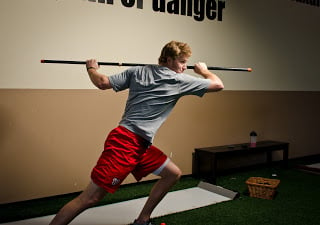
Warriors and hunter gatherers never thought about how to balance their left and right leg. In fact, a greater imbalance probably meant they could throw a spear further or climb faster. So often we hear about the need to balance one side because it is a certain % weaker than the other. But this “imbalance” can also be viewed as necessary specialization, whether it is swinging a sword or dunking a basketball. Athletes develop this imbalance because of their sport, and it can actually help their performance. This need for balance will even vary by sport. For example, it is not going to help overhead athletes to throw from both sides. Field and court players can always benefit from equal agility, yet will always have a plant or power leg to drive from. Such imbalance between legs might even prevent injury risk, because the sequence and timing will be that much better on the dominant side. So should we even address these imbalance, and if so when?
Asymmetry can be defined as lack of balance, but the key is that such imbalance does not occur between legs, but between sides so the best term is laterality. Laterality is the preference for one side of their body over the other. The origin, like most movement and actions, is the nervous system, particularly the brain. It is suggested that the left brain is dominant over the right because it is the language hemisphere. This left brain controls the right side of the body so the right side is generally stronger.
One of the defining circumstances that show laterality, and thus “imbalance” is the speed of movement. Previous research has proven slower movements allow greater symmetry between athletes. And a more recent study examined this factor in regards to a slower movement, the squat. This 2011 paper out of Colorado State University, examined subjects performing 5 sets of 8 reps with one foot on each force plate to measure ground reaction force (GRF). This protocol was chosen because it is also fatiguing, which would further slowdown the movement. The authors found that subjects’ asymmetries did not increase with fatigue, and some individuals even performed more balanced!
It is generally agreed that these differences occur due to neurological processes, hence the authors’ interest in investigating fatigue’s role in asymmetry.
We evaluate our asymmetries via the force plate as well, but use a more dynamic movement, the vertical jump. Athletes’ asymmetries are evident when the movement has insufficient DRIVE of GRF. It makes sense in that a dangerous imbalance, not a natural laterality, would force you to shorten your movement prematurely and cause a shorter DRIVE.
A more basic, field test is to compare agility movements from both sides to see the symmetry. Action should be taken when the imbalance shows differences between 15-20%. The solution is similar; more TIME during the movement, whether it is the exercise, nature, tempo, or even more repetitions to induce fatigue. One of our favorites is 3-5 sets of 6-10 reps Single Leg Deadlift shown below.
Your 3 Keys on Imbalance
Everyone has an imbalance and it’s not always a bad thing
Low DRIVE is an indicator of a dangerous imbalance
Fix imbalance with slower (single leg), fatigue inducing (higher rep) movements
However, if you lack speed or explosion, do not waste your time on asymmetries yet, you just don’t have the engine to drive fast enough. You must develop a greater laterality first, before you can even address it.